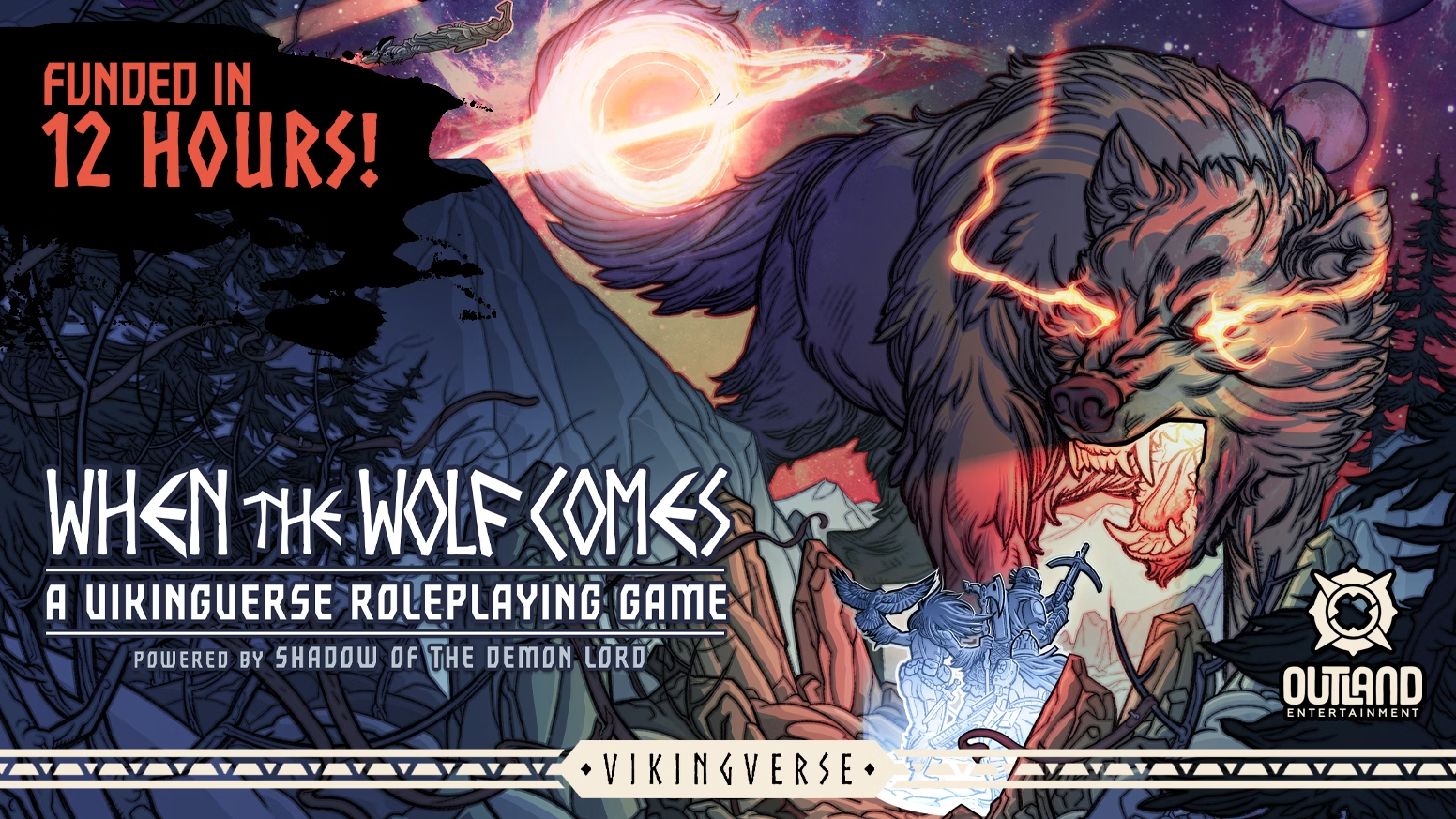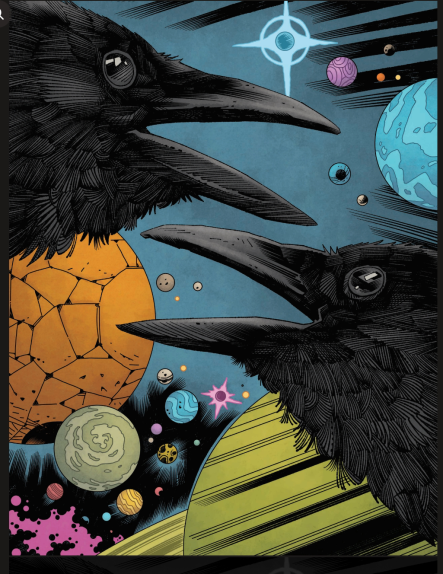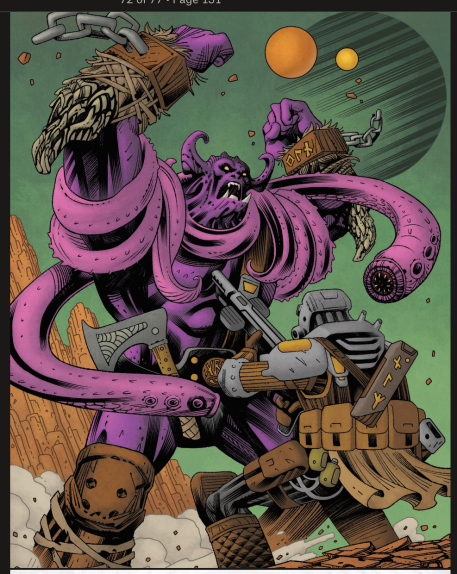
Hello and welcome to The RPG Academy’s The Review series. Today The Caleb G (@TheCalebG) takes a look at When the Wolf Comes by Ian Sharp ( @VikingVerse) in partnership with Schwalb Entertainment.
Howdy cats and kittens! It’s TheCalebG aka Professor Crunch aka the founder of Point Five Past.Today I’m here to review When the Wolf Comes, a Schwalb Entertainment game created by Ian Stuart Sharpe. The book was successfully funded at 458% back in Summer of 2022. At the time of writing this article, the book is available on DriveThruRPG along with many adventure modules, novels, and comics. The publisher was kind enough to send a copy of the game book for the purpose of this review.
Quick Overview
When the Wolf Comes presents the game rules for the Vikingverse, a series of stories set in an alternate timeline where Vikings are the dominant culture on Earth and in space. The game uses the Shadow of the Demon Lord rules.
Book and Resources
The book is massive, at almost 400 pages. About half the book is dedicated to rules and character options for players. There’s about 30 pages of setting details and about 50 pages of game runner guidance. A bestiary takes up another 50ish pages. The remainder of the book includes a sample adventure and two appendices.
Even though the book is large and dense, it’s easy to read and use when playing. The layout is smooth and there’s a very detailed table of contents and index. There is no wasted space in this book. Every inch is packed with information and details.
The star of the book is its gorgeous art, which seems to be a blending of Mike Mignola and Jack Kirby. It’s vibrant and evocative, helping immerse players in the unique style of the Vikingverse.
Beyond this core book, there are a vast amount of resources to help inform players about the Vikingverse and immerse them in this fantastic world. Key among these is the Thought and Memory Saga, a campaign designed to take character from level zero to ten. There’s also Space Vikings, a supplement providing additional character options and rules.
Story
At first glance, the Vikingverse story is simple. All Norse mythology and magic is real. Viking culture became dominant prior to 900 AD and shaped the rest of human development. There is a blend of magic and science as humanity and others explore the cosmos.
But the truth of the fiction goes far deeper. The Vikingverse is actually a divergent timeline driven by Odin altering reality to avoid Ragnarok. But since ultimately Ragnarok can only be delayed, the universe experiences various chaotic events as fate tries to rectify what was done. These events drive the overall plot of the Vikingverse as explored in its source novels and comics.
Mechanics
When the Wolf Comes is built on the Shadow of the Demon Lord framework. The core mechanics are exactly the same. A d20 plus modifier roll resolves everything. There are four attributes along with a few derived characteristics. What would be called a skill check in other systems are called challenges here and are always rolled against a target value of 10. The Boon and Bane system functions the same way but they are instead called Weals and Woes.
There are rules for gaining Trauma when encountering the worst parts of the universe. An excessive amount of Trauma can induce Shell Shock which grants randomized mostly negative effects. Trauma can be removed by gaining permanent disorders. There’s also a system of social status based on gaining Honor and Shame through how story events are roleplayed.
Character Creation and Gameplay
Again, everything in When the Wolf Comes functions exactly like Shadow of the Demon Lord. Characters start at level zero with nothing but Origins and Professions. Origins are more than simply a description of where the PC comes from. They define Attributes and Characteristics, as well as provide special abilities that advance with level progression. They also have incredibly robust options to create differences within each Origin. Most of these options are focused on flavor, but some provide mechanical differences. Professions are focused on flavor, helping define what the PC was doing before embracing a life of adventure.
As with the art, the Origins serve to bring the unique elements of the Vikingverse to the forefront. There are only ten options, but it feels like there are far more given the wealth of variation within each one. Also, the Origins are fascinating, pushing far beyond the classic tropes of high fantasy. Each Origin is presented with a short description of its place in Vikingverse lore, but that description is rich with details.
After playing through an introductory game that serves as an advanced session zero, players pick their first level of a Novice Path, which grants various class abilities. The intent here is that this choice is inspired by the gameplay of that session zero instead of simply being an arbitrary choice made while reading the book. This intent continues as players are encouraged to make choices for their Expert and Mythic paths based more on roleplay and game events.
Gameplay in When the Wolf Comes is fun, fast, and deadly. This is not a “big damn hero” game. Instead it’s a tough game where each roll is tense and survival is not guaranteed. Once again, this is true to the source material of Shadow of the Demon Lord.
Opinion
I absolutely love this setting and book. It’s gorgeous. The art is spectacular. Maybe it’s the unique setting, maybe it’s the different style, but I feel like this art is some of the most impressive I’ve seen in a gaming book ever.
The Vikingverse is a carefully-crafted setting that turns typical high fantasy tropes on their side with logic and consistency. Nothing is done by accident or just to be different. It’s refreshing to see such a unique take on mythological lore and how that influences the game set in this world.
Personally, I never found a way to really engage with Shadow of the Demon Lord. I can appreciate the setting and mechanics and understand their palace in the tabletop hobby, but they just never clicked with me. I don’t enjoy a game that is so punishing to players, instead preferring my gaming escapism to allow those big heroic moments facilitated by lots of big numbers on the dice. But I both understand and love this version of the rules. The setting and lore are more appealing to me, so that’s a huge factor. But something in how it’s presented here just makes more sense to me.
Another detail I love is how the lore is presented. I had no idea this game was based on novels and comics. My guess is that the average gamer will not either. They’ll probably stumble across the book based on the impressive cover art and then get hooked with the overall concept. Thus, the fact that there’s a one-page summary of the lore at the start of the book is a genius approach. Many games that present unique settings spend a lot of pages introducing the setting before explaining the rules. That’s a fine tactic, but one that I don’t appreciate. I want to explore the setting by understanding the rules, and that’s how When the Wolf Comes approaches things. That summary captures readers by telling them everything they need to know about the lore and then locks them in by presenting Origins like living robots, mutated animals, and corporate clones with brilliant art. Then, 200 pages later, readers get deeper details on Vikingverse lore. This is such a smart approach.
Ian Stuart Sharpe has created a vibrant, unique world with love and attention to detail. This game is a beautiful addition to the Vikingverse and a shining example of how to adapt an existing property to a tabletop game. The decision to use Shadow of the Demon Lord as foundation for this game was completely right as the system beautifully supports the tone of the Vikingverse stories. This book has my absolute highest praise and recommendation.
Rating: A+
Buy a copy on DriveThruRPG and support our Show HERE
Please consider contributing to my Patreon, making a modest donation via Paypal or even support your show at no extra cost via your purchases on DriveThru RPG.
Email: TheRpgAcademy@gmail
Twitter / Facebook / Website
Our Intro and Outtro music is Fly a Kite by Spectacular Sound Productions used via Creative Commons Attribution License
Playing Roleplaying games can be an amazingly fun time and also a benefit to your well being. If you or someone you know is struggling with your mental or emotional well being, please reach out to someone who can help:
National Suicide Prevention Lifeline: 1-800-273-8255
Crisis Text Line: Text HOME to 741741




